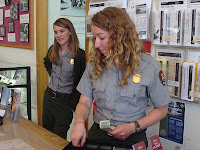We both woke up with the feeling it was time to head for
home. Getting out of Vegas was a hassle,
with traffic, and we were trying to find a simple place for breakfast and it is
clear that Vegas is a town built for the night not for the morning. Places were either strange bars, had no
parking or weren’t yet open. We opted to
get out of town and eat granola bars and yogurt from our own stock. Time to head home!
It is always good when coming back form a long trip, to get
to the Welcome to California sign.
Almost home.
Just after we passed the border we could again see the new solar plant. It is the largest such plant in the world. It uses mirrors to focus the sun on towers to heat a solution into steam which drives generators to create electricity. These arrays are unbelievably huge, spreading across the valley floor. Those mirrors facing somewhat in our direction certainly were bright. We agreed that we did not want to be responsible for dusting all of those mirrors.
We were struck again by how dry the Mojave Dessert is. The drive through the mountains and valleys are an ever changing mosaic of rocks, sand, and very hardy plants. At this point in our trips we always do some reflection. It gives us a chance to not only quantify what we have done but to discuss what it has meant to us.
Just after we passed the border we could again see the new solar plant. It is the largest such plant in the world. It uses mirrors to focus the sun on towers to heat a solution into steam which drives generators to create electricity. These arrays are unbelievably huge, spreading across the valley floor. Those mirrors facing somewhat in our direction certainly were bright. We agreed that we did not want to be responsible for dusting all of those mirrors.
We were struck again by how dry the Mojave Dessert is. The drive through the mountains and valleys are an ever changing mosaic of rocks, sand, and very hardy plants. At this point in our trips we always do some reflection. It gives us a chance to not only quantify what we have done but to discuss what it has meant to us.
So, what did we do on our summer vacation? During the past five weeks we:
* Visited 12 states
* Went to 10 national parks, 4 national monuments,
and 10 national historic sites
* Went to 5 museums, 1 zoo, 1 landscape arboretum
* Drove about 7,000 miles
* Went on a river raft float trip
* Went to many ranger talks and the victors
centers at each of the parks
* Saw family and friends
* Saw bison, mule deer, elk, wild burros, wild
horses, rabbits, prairie dogs, golden mantel ground squirrels, sand hills
cranes, chimp monks, bald eagles, osprey, peregrine falcons, cormorants,
vultures, red-tailed hawks, white pelicans, skunks, prong horn, moose,
* Drove through low desert, high desert, alpine
mountains, prairie, hardwood forest, arboreal forest
* We saw license plates from every state except
for Rhode Island, and lots of the Canadian provinces
* Were in three different time zones
* Experienced temperatures from 34 to 104 degrees
 |
| Home |
“All
journeys eventually end in the same place, home.”
― Chris Geiger
― Chris Geiger












































